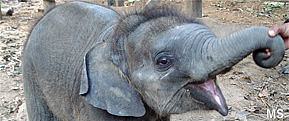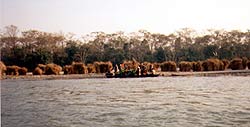 |
Nepal National Parks Chitwan |
|
 |
|
Animals
of riverbanks: Gharial Crocodiles
|

|

|
|
Gharial |
|
 Common
names Common
names |
 Indian
gharial, Indian gavial (the latter probably created by a misspelling, even
carried to the genus - name derived from an Indian pot, a ghara, which
resembles the bulbous nasal appendage present on mature males), Fish-eating
crocodile, Gavial del Ganges, Gavial du Gange, Long-nosed crocodile, Bahsoolia,
Nakar, Chimpta, Lamthora, Mecho Kumhir, Naka, Nakar, Shormon, Thantia,
Thondre, Garial Indian
gharial, Indian gavial (the latter probably created by a misspelling, even
carried to the genus - name derived from an Indian pot, a ghara, which
resembles the bulbous nasal appendage present on mature males), Fish-eating
crocodile, Gavial del Ganges, Gavial du Gange, Long-nosed crocodile, Bahsoolia,
Nakar, Chimpta, Lamthora, Mecho Kumhir, Naka, Nakar, Shormon, Thantia,
Thondre, Garial |
 Area
distribution Area
distribution |
 Northern
India subcontinent: Bangladesh (close to being extirpated), Bhutan (possibly
extirpated), India, Myanmar (possibly extirpated), Nepal, Pakistan
(close to being extirpated). They are found within the river systems of
the Brahmaputra (Bhutan & India), the Indus (Pakistan), the Ganges
(India & Nepal), and the Mahanadi (India), with small populations in
the Kaladan and the Irrawaddy in Burma. Northern
India subcontinent: Bangladesh (close to being extirpated), Bhutan (possibly
extirpated), India, Myanmar (possibly extirpated), Nepal, Pakistan
(close to being extirpated). They are found within the river systems of
the Brahmaputra (Bhutan & India), the Indus (Pakistan), the Ganges
(India & Nepal), and the Mahanadi (India), with small populations in
the Kaladan and the Irrawaddy in Burma.
 Habitat Habitat |
 Riverine
- more adapted to an aquatic lifestyle in the calmer areas of deep, fast-moving
rivers. The gharial is poorly equipped for locomotion on land. It
usually only leaves the water to bask and nest, both of which usually occur
on sandbanks. Riverine
- more adapted to an aquatic lifestyle in the calmer areas of deep, fast-moving
rivers. The gharial is poorly equipped for locomotion on land. It
usually only leaves the water to bask and nest, both of which usually occur
on sandbanks.
 Estimated
wild population: 2,500 to 3,500 Estimated
wild population: 2,500 to 3,500
 Summary:
Fragmented distribution, but population recovering due to positive conservation
efforts which continue today Summary:
Fragmented distribution, but population recovering due to positive conservation
efforts which continue today

|
|
Gharial |
|
 Appearance Appearance |
 Characteristic elongate, narrow snout, similar only to the false gharial,
(Tomistoma schlegelii). Characteristic elongate, narrow snout, similar only to the false gharial,
(Tomistoma schlegelii).
 Variation in snout shape occurs with age (generally becomes proportionally
longer and thinner with increasing age). Variation in snout shape occurs with age (generally becomes proportionally
longer and thinner with increasing age).
|
 The bulbous growth on the tip of the male's snout is called a 'Ghara' (after
the Indian word meaning 'pot'), present in mature individuals. It has several
functions attributed to it: a vocal resonator (which produces a loud buzzing
noise during vocalisation), a visual stimulus to females, and the production
of bubbles associated with sexual behaviour. The bulbous growth on the tip of the male's snout is called a 'Ghara' (after
the Indian word meaning 'pot'), present in mature individuals. It has several
functions attributed to it: a vocal resonator (which produces a loud buzzing
noise during vocalisation), a visual stimulus to females, and the production
of bubbles associated with sexual behaviour.
 The elongated jaws are lined with many interlocking, razor-sharp teeth
- an adaptation to the diet (predominantly fish in adults). The gharial
is one of the largest of all crocodilian species, approaching C. porosus
in maximum size - males reach at least 5 metres in length, and often approach
6 metres. Reports of 7 metre animals exist, but are unconfirmed. The elongated jaws are lined with many interlocking, razor-sharp teeth
- an adaptation to the diet (predominantly fish in adults). The gharial
is one of the largest of all crocodilian species, approaching C. porosus
in maximum size - males reach at least 5 metres in length, and often approach
6 metres. Reports of 7 metre animals exist, but are unconfirmed.
 The gharial is poorly equipped for locomotion on land - the leg musculature
is not suited to raise the body off the ground (to produce the 'high-walk'
gait - being able only to push its body forward across the ground ('belly-sliding'),
although it can do this with some speed when required. It is, however,
very agile in the water - the tail is well-developed and laterally flattened,
and the rear feet possess extensive webbing.
The gharial is poorly equipped for locomotion on land - the leg musculature
is not suited to raise the body off the ground (to produce the 'high-walk'
gait - being able only to push its body forward across the ground ('belly-sliding'),
although it can do this with some speed when required. It is, however,
very agile in the water - the tail is well-developed and laterally flattened,
and the rear feet possess extensive webbing.
top
|
Chitwan
National Park begins artificial hatching of Gharials |
April
2002With
an aim to preserve the rare Gharial crocodile, the Royal Chitwan National
Park (RCNP) have begun collecting the eggs from its natural habitat. The
egg will be hatched under the direct inspection of the RCNP experts. The
RCNP decided to take this step, as the number of crocodile of this species
was decreasing due to different reasons. The eggs of crocodile could not
prosper in the natural habitat, as the people used to steal them for medicine
use. Sometimes they were swept away by flood and were also eaten by wild
animals.
The
Park decided to finish the egg collection work within the first week of
Baishakh (April-May), as crocodiles lay eggs in this season. Prior to the
collection of the eggs, a team will undergo research in the natural habitat
of crocodiles. The necessary work for the egg collection has already begun
in the banks of Narayani, Kaligandaki and Rapti area,. The eggs will then
be taken to the Gharial Crocodile Reproductive Centre inside the
RCNP. The egg will hatch after it is kept in the sand for 60-90 days. Then
the hatched babies will be kept in the artificial pond, which will be released
in its natural habitat after three years old. The survival rate in the
natural habitat is only one percent where as under the artificial hatching,
30 percent will survive among 80 to 90 percent of hatched babies.
The
Reproductive Centre has been working to preserve the Gharial crocodile
since its establishment in 1978. And the Centre has released around 518
baby crocodiles in different rivers like Narayani, Kaligandaki, Babai and
Koshi till date. The Centre had released 10 Gharial crocodiles in the Narayani
River in February last year. There are altogether 145 crocodiles of different
age group, 123 of them Gharial and 22 Magar. It is estimated that a Gharial
female can lay around 32-62 eggs at a time.
Out
of 21 types of crocodiles in the world, 9 types are in critical condition.
These Gharial crocodiles are found only in Nepal, India, Pakistan, Bangladesh
and Bhutan. Crocodiles are in danger due to various reasons like they are
killed for skin, floods sweep away their eggs, lack of fish (their main
food) in the rivers and the threat from their own bigger adults.
|
Links
|
 |
 |
 |
External
links |
|


![]() Northern
India subcontinent: Bangladesh (close to being extirpated), Bhutan (possibly
extirpated), India, Myanmar (possibly extirpated), Nepal, Pakistan
(close to being extirpated). They are found within the river systems of
the Brahmaputra (Bhutan & India), the Indus (Pakistan), the Ganges
(India & Nepal), and the Mahanadi (India), with small populations in
the Kaladan and the Irrawaddy in Burma.
Northern
India subcontinent: Bangladesh (close to being extirpated), Bhutan (possibly
extirpated), India, Myanmar (possibly extirpated), Nepal, Pakistan
(close to being extirpated). They are found within the river systems of
the Brahmaputra (Bhutan & India), the Indus (Pakistan), the Ganges
(India & Nepal), and the Mahanadi (India), with small populations in
the Kaladan and the Irrawaddy in Burma.![]() Riverine
- more adapted to an aquatic lifestyle in the calmer areas of deep, fast-moving
rivers. The gharial is poorly equipped for locomotion on land. It
usually only leaves the water to bask and nest, both of which usually occur
on sandbanks.
Riverine
- more adapted to an aquatic lifestyle in the calmer areas of deep, fast-moving
rivers. The gharial is poorly equipped for locomotion on land. It
usually only leaves the water to bask and nest, both of which usually occur
on sandbanks.
![]() Estimated
wild population: 2,500 to 3,500
Estimated
wild population: 2,500 to 3,500
![]() Summary:
Fragmented distribution, but population recovering due to positive conservation
efforts which continue today
Summary:
Fragmented distribution, but population recovering due to positive conservation
efforts which continue today![]() The bulbous growth on the tip of the male's snout is called a 'Ghara' (after
the Indian word meaning 'pot'), present in mature individuals. It has several
functions attributed to it: a vocal resonator (which produces a loud buzzing
noise during vocalisation), a visual stimulus to females, and the production
of bubbles associated with sexual behaviour.
The bulbous growth on the tip of the male's snout is called a 'Ghara' (after
the Indian word meaning 'pot'), present in mature individuals. It has several
functions attributed to it: a vocal resonator (which produces a loud buzzing
noise during vocalisation), a visual stimulus to females, and the production
of bubbles associated with sexual behaviour.
![]() The elongated jaws are lined with many interlocking, razor-sharp teeth
- an adaptation to the diet (predominantly fish in adults). The gharial
is one of the largest of all crocodilian species, approaching C. porosus
in maximum size - males reach at least 5 metres in length, and often approach
6 metres. Reports of 7 metre animals exist, but are unconfirmed.
The elongated jaws are lined with many interlocking, razor-sharp teeth
- an adaptation to the diet (predominantly fish in adults). The gharial
is one of the largest of all crocodilian species, approaching C. porosus
in maximum size - males reach at least 5 metres in length, and often approach
6 metres. Reports of 7 metre animals exist, but are unconfirmed.
![]() The gharial is poorly equipped for locomotion on land - the leg musculature
is not suited to raise the body off the ground (to produce the 'high-walk'
gait - being able only to push its body forward across the ground ('belly-sliding'),
although it can do this with some speed when required. It is, however,
very agile in the water - the tail is well-developed and laterally flattened,
and the rear feet possess extensive webbing.
The gharial is poorly equipped for locomotion on land - the leg musculature
is not suited to raise the body off the ground (to produce the 'high-walk'
gait - being able only to push its body forward across the ground ('belly-sliding'),
although it can do this with some speed when required. It is, however,
very agile in the water - the tail is well-developed and laterally flattened,
and the rear feet possess extensive webbing.


